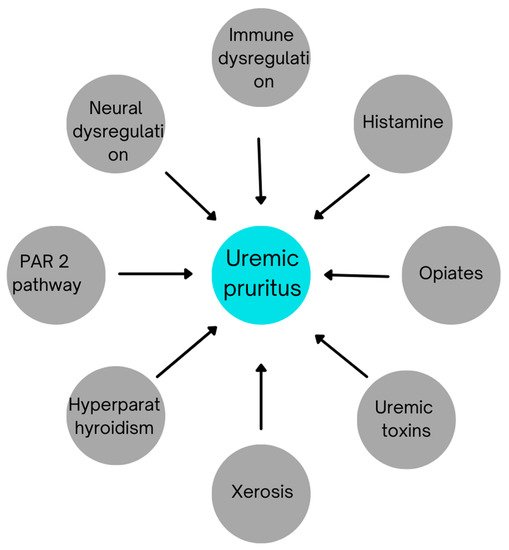There are various risk factors associated with CKD-aP. Many studies have evaluated these factors and have reported variable results. In an international prospective cohort study on HD patients, the patients with pruritus were older, had higher median C-reactive protein, and had hepatitis B or C antibodies and low serum albumin. However, no association was observed with parathyroid hormone (PTH), Kt/V, serum calcium, phosphorus, calcium phosphorus product, and hemodiafiltration
[2]. DOPPS data suggested that the likelihood of moderate to extreme pruritus was more in male patients or patients with a history of systemic diseases involving the heart, lungs, central nervous system, or liver. Higher serum phosphorus (>5.5 md/dL) or serum calcium (>10.2 mg/dL) levels, higher calcium phosphate (>80 mg
2/dL
2), lower serum or white blood cells >6700 /mL were also independent risk factors. The following factors were found to be negatively associated with pruritus: early ESRD (3 months or less), or prolonged ESRD >10 years, or serum ferritin concentration ≥400 ng/mL. It was also observed that an increase in dialysis dose improved pruritus
[4]. In a Japanese DOPPS (JDOPPS) study, some additional risk factors were identified for CKD-aP, such as: hypertension, high PTH levels, smoked within the past year, and arteriovenous graft as the primary vascular access. They did not find any relation of CKD-aP with hepatitis B, serum creatinine, body mass index, dialyzer membrane type or flux of the dialyzer, percentage transferrin saturation, neutrophil count, and residual renal function
[5]. In a study on 5658 patients with CKD stage 3–5 managed without dialysis, the following patient characteristics were associated with a higher prevalence of moderate-to-extreme pruritus: older age, female sex, history of lung disease and diabetes, higher serum phosphate, and lower hemoglobin levels. The prevalence was higher in patients with advanced stages of CKD
[14]. Ozenet al. from Turkey found inflammatory mediators to be elevated in patients with CKD-aP. They found that WBC counts ≥ 6.7 × 10
3/μL increased the risk of pruritus by 1.73 times. Serum proinflammatory cytokines (IL-6, CRP, etc.) were found to be higher in CKD-aP patients
[19]. In a prospective cohort study of 85 PD patients in Taiwan, 28.2% of patients had pruritus. Technical faults in PD lead to a higher intensity of pruritus and worse patient survival in patients undergoing dialysis. They also found that higher blood levels of iPTH, higher dietary protein intake, long duration of dialysis, weekly total Kt/V ≤ 1.88, and high-sensitivity CRP were independent determinants of higher Visual Analog Scale scores of pruritus intensity
[20]. A cross-sectional study was conducted in Korea amongst 223 PD and 425 HD patients. They observed that peritoneal dialysis and BMI were independently responsible for pruritus. The severity of pruritus was negatively correlated to total weekly Kt/V in PD patients and serum albumin levels in HD patients. In PD patients, it was positively correlated with duration of dialysis, total cholesterol levels, and systolic BP. Amongst all these factors, serum albumin levels in HD and total weekly Kt/V in PD were independently found significant. However, clinically, there was no significant difference between PD and HD patients in the distribution of pruritus, frequency of pruritus-related sleep disturbances, pruritus intensity, and scratching activity
[9]. Ko et al. followed up 111 patients of maintenance hemodialysis with CKD-aP for 4 years. They compared the parameters in patients with improved and unimproved pruritus at the end of follow-up. Lower levels of calcium and phosphorus products, low serum phosphorus, and ferritin were seen in patients with improved pruritus. In the study, the factors responsible for increased severity of pruritus over time were: female gender, low uric acid at baseline, use of low-flux dialyzer, high urea nitrogen, and β2- microglobulin, lowKt/V at baseline, low baseline VAS score, total bilirubin at baseline, high creatinine, preprandial glucose, and high calcium and phosphate product at baseline. It was also observed that a baseline Kt/V˂ 1.5 had severe pruritus, while the use of a high-flux dialyzer led to improvement in pruritus
[21]. A study by Tinghai Hu et al. did not find serum calcium levels to be associated with pruritus. In a meta-analysis of cross-sectional studies, dialysis duration was negatively associated with the prevalence of CKD-associated pruritus
[7]. To summarize all these findings, low levels of serum albumin and high levels of serum C-reactive protein, phosphorus, PTH, and calcium phosphorous products are positively correlated with higher intensity of pruritus. Coinfection with Hepatitis C and white blood cells >6700 /mL also increases the intensity of pruritus. Dialysis efficiency also affects pruritus, and low Kt/V increases pruritus. Older age, female sex, and presence of comorbidities such as lung disease and diabetes mellitus are also poor prognostic factors.

